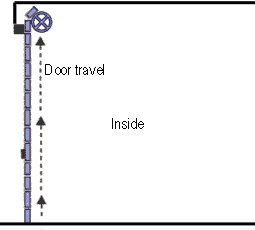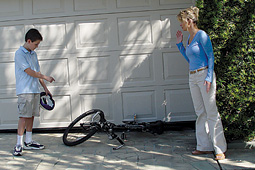What is your garage door type?!? That might seem like a silly question. Why? When we think of a garage we generally think of only one type. The most common type is the sectional garage door, but there other type to choose from. It is true we all want to be like our neighbors and if the Jones’ have a sectional garage door, then we should have a sectional garage door. Here is a brief overview of the basic garage door types. Depending on the use of your garage or the style that you like. You never know you might prefer one type over the other.
Retractable Doors

Retractable Grage Door
A large proportion of the door swings outwards as it opens and then slides away into the ceiling of your garage, pivot points are located at the top of the door, consequently you are unable to park too close to the garage door.
These doors are fairly easy to install with spring assemblies being fitted to the side frames and tracks to the top which support the top of the door, the latter being secured a couple of meters into your garage. They are however the easiest type of door to automate with any electric opener being suitable.
Security is generally pretty good with manufacturers often fitting four latches, but when automated these latches are disabled and the door could possibly be forced open at the base depending on set-up, however, an automatic de-latching system is available to counter this problem.
Retractable doors are generally available in all materials: Steel, Timber, GRP and ABS. Pre-framed versions are available.
With this door type fitted you will have a fairly drafty garage and drive-though width will be reduced because of the side spring assemblies, although some manufacturers have an optional mechanism which avoids this.
Canopy Doors

Canopy Garage Door
The door swings outwards as it opens (but not so much as a retractable door) it then slides upwards into the ceiling of your garage leaving one-third of the door protruding outside the garage and taking up less room inside. You are unable to park too close to the garage door.
Pivot points are located two-thirds of the way down the door, which helps improve the security of the door. Pre-framed versions are available.
Canopy doors are the easy to install as the entire door mounts to the door frame and no tracks are required inside the garage. The down side is that automating a canopy door is not recommended – with the exception of Cardale canopy doors which can be automated very well with a specially designed Autoglide opener but it is a little more expensive than normal electric openers.
Canopy doors are generally available in all materials: Steel, Timber, GRP and ABS. With this door type fitted you will have a fairly drafty garage although the drive though width will not be reduced beyond the door frame.
Sectional Doors

Sectional Garage Door
Sectional doors (made up of several separate horizontally hinged panels) fit to the rear surface of the front brickwork of your garage, and as such need a small amount of clear brickwork to the sides and top of your opening. The entire door rises vertically upwards and then backwards into the ceiling space. No door frame is required which increases the available drive-through width.
Good security and good protection against the weather with sealing all around the door, doors with or without insulation are available. Sectional doors are generally manufactured in steel although some specialist timber versions are available.
Easy to automate as any motor is suitable – a soft start/soft stop opener gives a real touch of class. Easy to fit as the doors come in kit form and are assembled in approximately 4 hours.
Roller Doors

Roller Garage Door
Roller doors are a single curtain that rolls up into your garage ceiling. They fit to the rear surface of the front brickwork of your garage, and as such need a small amount of clear brickwork to the sides and between 450 and 205mm ceiling clearance above the underside of the lintel. The entire door rises vertically upwards and then rolls up on a spindle in the ceiling space.
No door frame is required which increases the available drive-through width. Good security and good protection against the weather with sealing all around the door, doors with or without insulation are available. Roller doors are either manufactured in Steel or Aluminium and are either single sheet or hinged slat. Manual and electric versions are available. Installation is straight-forward but two people may be required to lift the curtain onto the support brackets in the ceiling of your garage.
Side Hinge Doors
A very traditional looking style of door that is manufactured in timber, GRP or steel. Side hinge doors open outwards and therefore need good clearance when being opened so not great if you have a short driveway or open directly onto a public area. A good choice if there is no clearance inside your garage to allow for an up and over door.
Security is good if you have overlapping leaves and use bolts at the top and bottom of the door. Automating this door is possible with the use of a Side Hinge Converter that attaches each wing to the electric operator.















